ISSN 2410-5708 / e-ISSN 2313-7215
Year 12 | No. 35 | October 2023 - January 2024
© Copyright (2023). National Autonomous University of Nicaragua, Managua.
This document is under a Creative Commons
Attribution-NonCommercial-NoDerivs 4.0 International licence.
Tourist perception of the inhabitants surrounding the nature reserves dedicated to tourism
https://doi.org/ 10.5377/rtu.v12i35.16999
Submitted on 08 th May, 2023 / Accepted on 13 th October, 2023
Jenny del Socorro Villanueva
Doctor in Economic Sciences, Professor of the Department
of Economic and Administrative Sciences, FAREM Chontales
UNAN-Managua.
Concepción Mendoza Castro
Master in Business Administration and Institutions, Professor
of the Department of Economic and Administrative Sciences,
Facultad Regional Multidisciplinaria de Chontales, UNAN-
Managua.
Ahixa Dahajanna Cruz Garcia
Degree in Tourism and Hotel Administration, UNAN-
Managua, FAREM Chontales.
Section: Social Sciences, Business Education and Law
Scientific research article
Keywords: Community, Perception, Natural Reserves, Tourism, Latin America.
Abstract
The main objective of this study is to determine the perception of the inhabitants about tourism in natural reserves. This research was initially field research because a survey was applied to students of Tourism and Hotel Management of the UNAN FAREM Chontales and then became a documentary by collecting information from previous research to determine the perception of the following Latin American countries: Peru, Argentina, Dominican Republic, Ecuador, and Uruguay from 2015 to 2020. To make the comparison, three factors were taken into consideration: economic: income and economic development; sociocultural: cultural preservation and quality of life; environmental: environmental preservation and pollution. Regarding the results obtained from the collection of data from the inhabitants of various communities in Latin America, these reflect a total of 2594 where 83.11% of the population has a positive perception of the economic factor: income, and 76.79% of economic development, according to the sociocultural factor 63.3% perceive cultural preservation and 80.53% consider that it improves the quality of life. Finally, with the environmental factor, 74.5% perceive environmental preservation and 25% consider that pollution increases.
INTRODUCTION
The Serranía de Amerrique Natural Reserve has begun to have some relevance in local tourism. Because of this, it was considered important to analyze the perception of the students of Tourism and Hotel Management, since they have a professional tourism vision that would help the owners generate a broader perspective of tourism in terms of the benefits that this activity can generate for the population.
Taking into account that tourism in natural reserves is a recent modality that has generated new concerns for tourism entrepreneurs, since in this not only the tourist is important but also what the resident community perceives because this perception can affect or benefit the tourism activity carried out in the area since the inhabitants are directly involved with the tourists.
For this reason, a comparison was made to determine the perception of the population of the communities about tourism in natural reserves in Latin American countries and to observe how positive the perception of the residents is and which factor is affecting the most.
The following factors were taken into consideration for this study: economic, socio-cultural, and environmental. These factors were subdivided into: Income and economic development (economic factor), cultural preservation and quality of life (socio-cultural factor), environmental preservation and quality of life (environmental factor).
MATERIAL AND METHOD
This research is mixed, since at the beginning fieldwork was carried out with the surveys applied to the students of Tourism and Hotel Administration of the UNAN FAREM Chontales and then it became a documentary with the information gathered from previous research on the perception of the inhabitants of the natural reserves of Latin American countries to make the comparison between them.
The methodology used for the collection of information was based on a structured instrument, in this case, the survey. This instrument was applied to 72 students of Tourism and Hotel Administration of the UNAN FAREM Chontales. As for the documentary study, the use of files was used for the collection and focalization of old data, as well as the application of the hermeneutic method. The information was compiled from research conducted between 2015 and 2021 in Latin American countries: Peru, Ecuador, Argentina, the Dominican Republic, and Uruguay. There the data of 2523 settlers living in the natural reserves were retaken, 1688 from Peru (Tambopata and Titicaca), 92 from Argentina (Pehuén Có), 576 from the Dominican Republic (Puerto Plata), 132 from Ecuador (Shiripuno) and 34 Uruguay (Aiguá).
RESULTS AND DISCUSSION
First, the students’ perception was analyzed from different points, since, as Ramírez mentions, “Perception is how the information received through the senses is interpreted and understood. The act of perceiving is the result of gathering and coordinating the data provided to us by the external senses (sensations)” (Ramirez, 2020, p. 192).
In the context of tourism, for authors such as Gunn (1988), Mathieson (1990), Wall (2006), Royo and Ruiz (2009), residents are very important for the development of tourism because they directly influence the quality of services and products offered to the visitor, they consider them part of the success of the projects. The perception of the willingness and support or, in some cases, even opposition of the residents for tourism development. That is why it was considered relevant to know the perception of students regarding tourism in the Serranía de Amerrique in general.
Figure 1
Students’ perception of tourism in the Serranía de Amerrique.

Note: The figure shows the perception of students Source: Cruz (2021)
Regarding the perception of the Serranía, 81% of the students consider that it has tourism potential, but lacks the conditions to provide a service. On the other hand, 14% consider that it is ready to receive tourists, 4% believe that it would function more as a complement to another tourist destination in Juigalpa, and 1% believe that it has no potential.
To make a comparison between the different residents of the Natural reserves, six communities from Latin American countries were considered, including the Serranía de Amerrique Reserve.
Figure 2
Number of settlers in Latin American communities
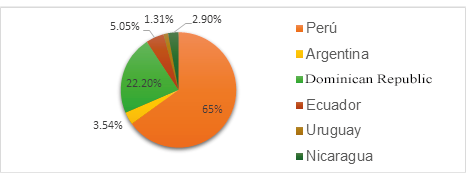
Note: The figure shows the number of settlers taken Source: Aragon (2018), Smurra (2019), Cañero (2018), Guijarro et al (2018), Rojas (2020), Cruz (2021).
The factors considered to determine tourism perception are: economic, sociocultural, and environmental since tourism is considered a social phenomenon, it cannot be separated from the population. The relationship between them is dual and they can affect each other. On the one hand, tourism can contribute to economic development, modernization, and social transformation; on the flip side, it can generate social and economic inequality, as well as cultural and natural deterioration (Fernández, 2009).
The economic factor was studied from the point of view of income and development, these being the most important sub-factors for the inhabitants since, according to Bialostozky (2010), economic development does not only imply that part of society is well off or that the community has improved infrastructure if there are still families that lack a decent life. Economic development refers to the welfare of all people, and for this reason, the first step for this progress is to generate jobs, which is the basis for ensuring equity in terms of the economic wealth of the community.
Table 1
Positive perception of the community for generating income from tourism activity
|
Country |
Inhabitants |
Income |
% per country |
|
Peru |
1688 |
1400 |
83% |
|
Argentina |
92 |
68 |
74% |
|
the Dominican Republic |
576 |
534 |
92.7% |
|
Ecuador |
132 |
97 |
73.4% |
|
Uruguay |
34 |
28 |
82.3% |
|
Nicaragua |
72 |
29 |
40.2% |
|
Total |
2594 |
2156 |
83.11% |
Note : Data taken from Aragón (2018), Smurra (2019), Cañero (2018), Guijarro et al (2018), Rojas (2020), Cruz (2021).
Out of 2594 inhabitants of the different communities, 2156 representing 83.11% perceive positively generating income from tourism activity. The Dominican Republic with 92.7% of inhabitants has the highest positive perception, followed by Peru with 83% and Uruguay with 82.3%, Argentina with 74%, Ecuador with 73.4%, and finally Nicaragua with 40.2%.
Table 2
The community perceives economic development due to tourism activity
|
Country |
Inhabitants |
Economic development |
% per country |
|
Peru |
1688 |
1196 |
70.8% |
|
Argentina |
92 |
78 |
84.78% |
|
the Dominican Republic |
576 |
560 |
97.22% |
|
Ecuador |
132 |
108 |
81.81% |
|
Uruguay |
34 |
30 |
88.23% |
|
Nicaragua |
72 |
20 |
27.78% |
|
Total |
2594 |
1992 |
76.79% |
Note: Data taken from Aragón (2018), Smurra (2019), Cañero (2018), Guijarro et al (2018), Rojas (2020), Cruz (2021).
According to the perception of economic development only 1992 inhabitants representing 76.79%, have perceived it. Mostly Dominican Republic with 97.22% of its inhabitants, followed by Uruguay with 88.23%, Argentina with 84.78%, Ecuador with 81.81%, Peru with 70.8% and Nicaragua with only 27.78%.
In Figure 3, students also considered that in terms of social benefit, 43.1% prefer tourism development and 27.8% prefer economic improvement. In Table 6, 40.3% expected to obtain employment within the nature reserve. This is a clear example that people will have a positive perception if they can count on the economic factor.
Figure 3
Social benefits that can be obtained from tourism in the Serranía
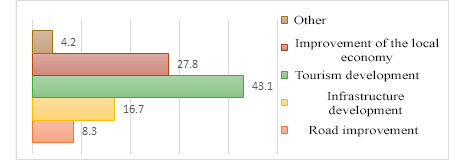
Note: The figure shows the benefits obtained through tourism. Source Cruz (2021)
Figure 4
Economic benefits that can be obtained as a future graduate in Tourism and Hotel Management from tourism in the Serranía.
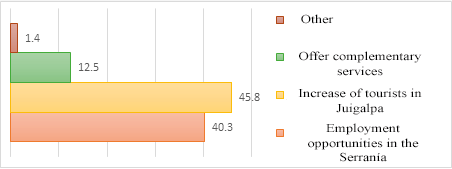
Note. The figure represents the economic benefits that would be obtained. Source Cruz (2021).
Continuing with the sociocultural factors, these are a mixture of both social and cultural factors, both go hand in hand and achieve a balance showing globally the society. Considering this, the sub-factors studied are cultural preservation and quality of life.
Table 3
Community perception of cultural preservation by tourism activity
|
Country |
Inhabitants |
Cultural preservation |
% per country |
|
Peru |
1688 |
915 |
54.2% |
|
Argentina |
92 |
54 |
58.7% |
|
the Dominican Republic |
576 |
511 |
88.71% |
|
Ecuador |
132 |
132 |
100% |
|
Uruguay |
34 |
32 |
94.11% |
|
Nicaragua |
72 |
0 |
0% |
|
Total |
2594 |
1644 |
63.3% |
Note. Data taken from Aragón (2018), Smurra (2019), Cañero (2018), Guijarro et al (2018), Rojas (2020), Cruz (2021).
In Jofre’s (1989) concept of culture, the word preserve is mentioned, since if culture is not preserved it cannot be transmitted and therefore cannot be acquired by the following generations, thus causing its total loss. It is therefore important to take measures to preserve it, especially when it is exposed to tourism. Having said this, 63% of the inhabitants considers that tourism does contribute to the preservation of culture, with Ecuador (100%) being the one that perceives it the most.
Figure 5
Tourism activities to be implemented in Serranía de Amerrique

Note: In the figure the tourism activities that can be implemented. Source Cruz (2021)
Regarding the opinion of the students, they confirm the importance of the villagers and their culture being part of tourism, with the most supported activities being archeology, legends, and learning about the daily life of the villagers.
Quality of life is a complex concept to define since depending on the social context this can have multiple interpretations and meanings, as well as being multifaceted. Hernández (2017) points it out as ‘’a substantial condition for full human development, it is a polysemic construct with concrete and feasible applications in different social contexts, from that versatility it addresses aspects that range from educational, generic, family, age, territorial’’ (p. 10). (p. 10).
Table 4
The community perceives quality of life through tourism activity
|
Country |
Inhabitants |
Quality of life |
% per country |
|
Peru |
1688 |
1337 |
79.2% |
|
Argentina |
92 |
56 |
60.8% |
|
the Dominican Republic |
576 |
549 |
95.3% |
|
Ecuador |
132 |
103 |
78.03% |
|
Uruguay |
34 |
26 |
76.4% |
|
Nicaragua |
72 |
18 |
25% |
|
Total |
2594 |
2089 |
80.53% |
Note. Data taken from Aragón (2018), Smurra (2019), Cañero (2018), Guijarro et al (2018), Rojas (2020), Cruz (2021).
Regarding the perception of quality of life 2089 out of 2594 residents 80.53% consider that quality of life improves thanks to tourism activity. The Dominican Republic has the highest representation with 95.3%.
Finally, the environmental factors are mainly water and air, although everything that is part of the ecosystem could be mentioned. These factors can affect the community if they are contaminated. This can generate discontent and even migrations. An example is the flora and fauna. This is why the sub-factors taken into account are environmental preservation and pollution.
Table 5
The community perceives environmental preservation due to tourism activity
|
Country |
Inhabitants |
Environmental preservation |
% per country |
|
Perú |
1688 |
1195 |
70.79% |
|
Argentina |
92 |
53 |
57.6% |
|
República Dominicana |
576 |
542 |
94.1% |
|
Ecuador |
132 |
120 |
91% |
|
Uruguay |
34 |
23 |
67.64% |
|
Nicaragua |
72 |
0 |
0% |
|
Total |
2594 |
1933 |
74.5% |
Note. Data taken from Aragón (2018), Smurra (2019), Cañero (2018), Guijarro et al (2018), Rojas (2020), Cruz (2021).
Out of 2594 inhabitants, only 1933 representing 74.5% perceive that tourism activity causes environmental preservation, being the residents of the Dominican Republic community with 94.1% who have the highest representation, followed by Ecuador with 91% of inhabitants, Peru with 70.79%, Uruguay with 67.64% and Argentina with 57.6%
Figure 6
Type of alternative tourism with the greatest potential in the Serranía de Amerrique.
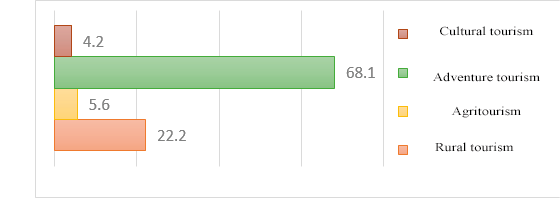
Note: In the figure type of alternative tourism that has the greatest potential in the Serranía de Amerrique. Source Cruz (2021)
Regarding the type of tourism, it can be observed that the students consider adventure tourism to have the greatest potential at 68.1%, in second place is rural tourism at 22.2%, in the last place is agrotourism at 5.6% and cultural tourism at 4.2%.
Table 6
The community perceives contamination from tourism activities
|
Country |
Inhabitants |
Pollution |
% per country |
|
Peru |
1688 |
493 |
29.2% |
|
Argentina |
92 |
71 |
77.17% |
|
the Dominican Republic |
576 |
55 |
9.54% |
|
Ecuador |
132 |
24 |
18.18% |
|
Uruguay |
34 |
5 |
14.7% |
|
Nicaragua |
72 |
0 |
0% |
|
Total |
2594 |
648 |
25% |
Note. Data taken from Aragón (2018), Smurra (2019), Cañero (2018), Guijarro et al (2018), Rojas (2020), Cruz (2021).
Out of 648 out of 2594 inhabitants representing 25% perceive pollution due to tourism activity. Mainly Argentina with 77.17% of inhabitants who perceive it, likewise Peru with 29.2%, Ecuador with 18.18%, Uruguay with 14.7%, and Dominican Republic with only 9.54%.
CONCLUSIONS
Concerning the general perception of the students of Tourism and Hotel Management, most of them consider that the Serranía de Amerrique has tourism potential and perceive tourism as something positive that will benefit the population and them personally.
Regarding the tourist perception that the Latin American population has of the natural reserves, during the period 2015-2020 it can be said that the perception will depend on the factors mentioned above.
Regarding the economic factor, the inhabitants of the communities perceive tourism activity in nature reserves positively if it generates income. In the case of the countries studied in the table presented above “Positive perception of the community for generating income from tourism activity” reflects that the majority of the inhabitants, with 83.11%, perceive income mainly in the community of the Dominican Republic. Likewise, the students of Tourism and Hotel Management maintain a positive perception if they receive some type of personal or socioeconomic benefit, such as the increase of tourists that contributes to the development of the community, generating jobs for them, or increasing the number of tourists by allowing them to offer complementary services (lodging, food, transportation).
Similarly in the perception of economic development Dominican Republic is the first, with this we can conclude that, in terms of the economic factor, this community is the one that is being most benefited monetarily. Since not only income is being received, but also jobs are being created that provide greater economic stability throughout the community, thus achieving a productive cycle.
According to the sociocultural factor, the inhabitants of the communities positively perceive cultural preservation and that tourism improves the quality of life. Table 3 “The community perceives cultural preservation through tourism” shows that 63.3% of the inhabitants have a positive perception of cultural preservation, with the community of Ecuador having the highest positive perception with 100%, since they believe that community tourism should be managed by the indigenous peoples and that the values and knowledge of the native communities should guide the activities and services offered. As for the other communities, most of them do not perceive this preservation, the reasons may be because the arrival of tourists has acculturated them and they do not have strategies to stop this consequence, as in the case of Argentina, which alludes that the development of tourism leads to the loss of local culture by adopting the foreign culture. For this reason, Figure 5 shows that tourism activities that are directly related to the local people and their culture should be carried out. These activities were selected by the students of Tourism and Hotel Management so that tourism in the Serranía de Amerrique can contribute to cultural preservation through the activities it offers.
On the other hand, concerning the quality of life, the community of the Dominican Republic is the one who has a higher perception collectively, this is a consequence of the economic factor since, although the quality of life includes health, education, social welfare; this is reached with economic and social development.
With the environmental factor, two very contrary actions can be generated, environmental preservation and pollution. Environmental preservation causes a positive perception of the inhabitants, in this case, the community of the Dominican Republic is the one who perceives it the most, since they consider that the environmental value is more and more recognized, that is why they have opted for new forms of alternative tourism such as Sustainable Tourism. The other communities also perceive it, although to a lesser extent. Although the percentage is not very low, it would be ideal if everyone could perceive it because, unlike the other factors, these affect not only the community but also the natural reserve, which should be protected. For this reason, Figure 6 shows the types of alternative tourism that are best suited for tourism in the Serranía de Amerrique and how well accepted they are by the students, considering adventure tourism to be the most appropriate.
Regarding pollution, 25% of the inhabitants perceive tourism as something negative, being the community of Argentina the one with the biggest problem. They mention that their main problem is the abundant amount of waste deposited on the coast, mainly by hikers. This problem has affected them to the point of receiving complaints from the tourists themselves.
Similarly, the high degree of achievement of the main objective is evident, where the perception of the inhabitants on tourism in natural reserves was determined, with the three selected factors: economic, socio-cultural, and environmental, highlighting that the tourist perception of the inhabitants is positive to these components. However, there are still aspects to be explored that would be beneficial to consider in future research.
Finally, this research from the university extension contributes to the initiative of the Serranía de Amerrique Geopark project, promoted by the local authorities of the department of Chontales. It also offered a broader perspective by correlating previous studies carried out in Latin American reserves.
ANNEXES
Illustration 1 Tambopata and Titicaca

Source: MapiTravel (2021)
Illustration 2 Pehuén Có
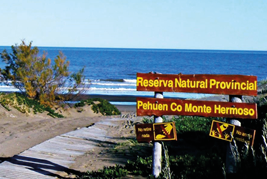
Source: La Región (2020)
Illustration 3 Puerto Plata
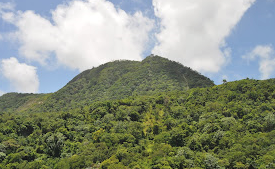
Source: Ponce, C (2017)
Illustration 4 Shiripuno
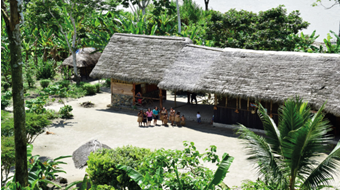
Source: Go Ecuador (n,f)
Illustration 5 Aiguá

Source: Artelista (2021)
Illustration 6 Amerrique mountain range
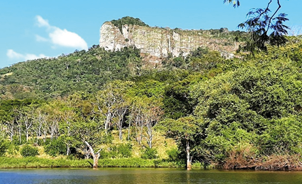
Source: Vargas, M (2021)
Works Cited
Alfonzo, I. (1994). Técnicas de investigación bibliográfica. Caracas: Contexto Ediciones.
Altamira, R. (2007). Turismo como motor de crecimiento económico. Anuario Jurídico y Económico Escurialense.
Aragón, R. (2018). Percepciones de gestión del turismo sostenible: estudio comparativo en dos comunidades aledañas a reservas nacionales (Tambopata Y Titicaca), Perú. Lima, Perú.
Bialostozky, C. J. (2010). Conceptos y definiciones en relación con el empleo el desempleo y el subempleo. México: Dirección General de Estadística.
Blasco, M. R. (2017). Un análisis de los factores socioculturales en el emprendimiento. Cartagena: Universidad Politécnica de Cartagena.
Bonilla, E., & Rodríguez, P. (1997). Mas allá del dilema de los métodos. Santa fe de Bogotá: Uniandes.
Cañero, P. (2018). Impactos del turismo comunitario y sostenibilidad en comunidades rurales de Puerto Plata (República Dominicana). Un análisis de la percepción de los residentes. Córdoba.
Cruz, A. (2021). Percepción de los estudiantes de Administración turística y hotelera sobre el turismo en la Serranía de Amerrique. Juigalpa: UNAN- Managua.
Fernández, J. (2009). Percepción Social del turismo. España: Universidad de las Islas Baleares.
Go Ecuador. (s,f). Centro de Turismo Comunitario Shiripuno [fotografía] GoEcuador. https://goecuador.net/guia-de-turismo/Centro-de-Turismo-Comunitario-Shiripuno-travel-ecuador
Hernández, J. (2017). Calidad de Vida, Inclusión Social y Bienestar Humano. UNERMB
JOFRE, M. A. (1989). Concepto de cultura. Santiago: CENECA.
La Región. (2020). Pehuen Co [fotografía]. La voz del pueblo. https://lavozdelpueblo.com.ar/noticia/102556-Pehuen-Co:-aventura,-naturaleza-y-ciencia-en-un-mismo-lugar
MapiTravel, (2021). Reserva Nacional de Tambopata [fotografía]. Machu Pichu. https://www.machupicchu.biz/reserva-nacional-de-tambopata
Pérez, E (2021). Salto del indio [Fotografía]. Artelista. https://www.artelista.com/en/artwork/5989613066749288-saltodelindio.html
Ponce, C (2017). Puerto Plata – República Dominicana [fotografía]. Diosa Si Blog de viajes. http://diosasi.blogspot.com/2017/09/el-parque-nacional-isabel-de-torres-el.html
Rojas, V. (2020). Percepciones de la población residente sobre los impactos turísticos en el desarrollo local. Estudio de caso: departamento de Maldonado, Uruguay. Aigua.
Smurra, F. (2019). La percepción de los residentes respecto a los impactos del turismo. Estudio de caso: Pehuen Có. Bahia Blanca.
Vargas, L. (1994). Sobre el concepto de percepción. México DF: Universidad Autónoma Metropolitana Unidad Iztapalapa.
Vargas, M. [Kem Vargas]. (2021, 3 de febrero). [post]. Facebook: Recuperado el 5
de julio de 2021,..de https://www.facebook.com/photo?fbid=4061595910519637set=pb.100000078059546.-2207520000.
